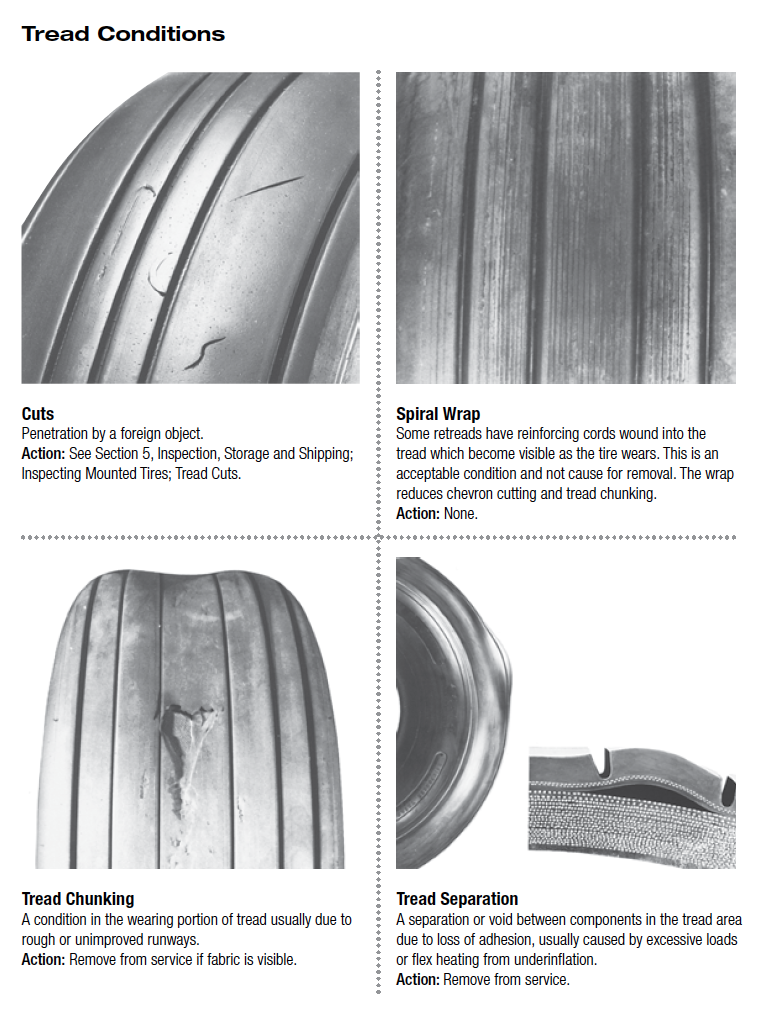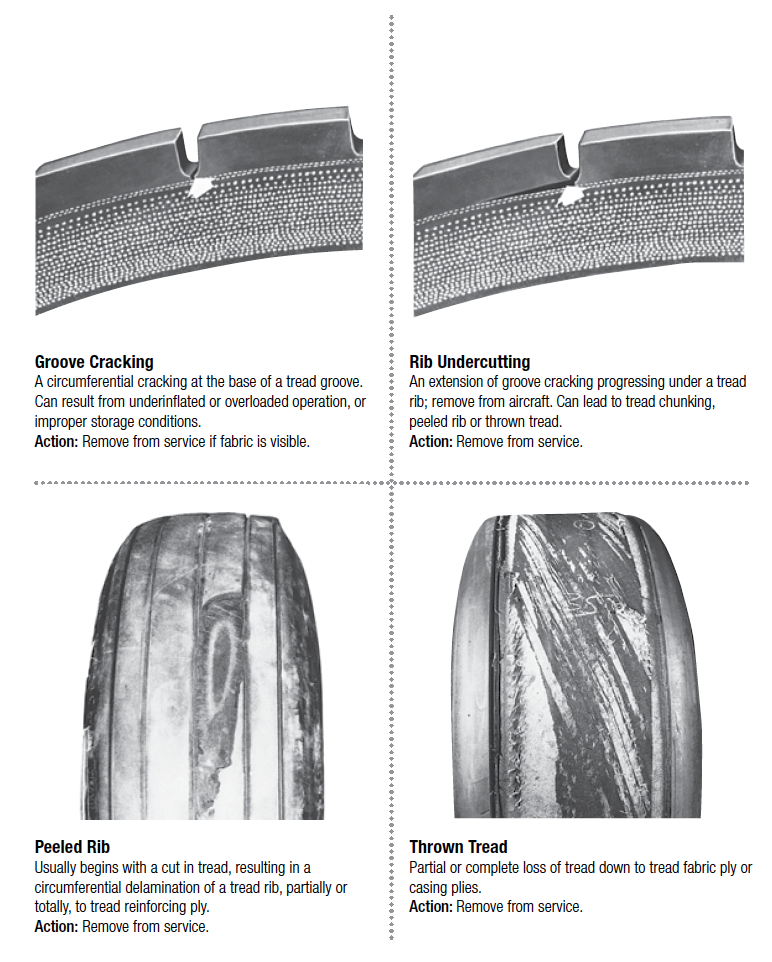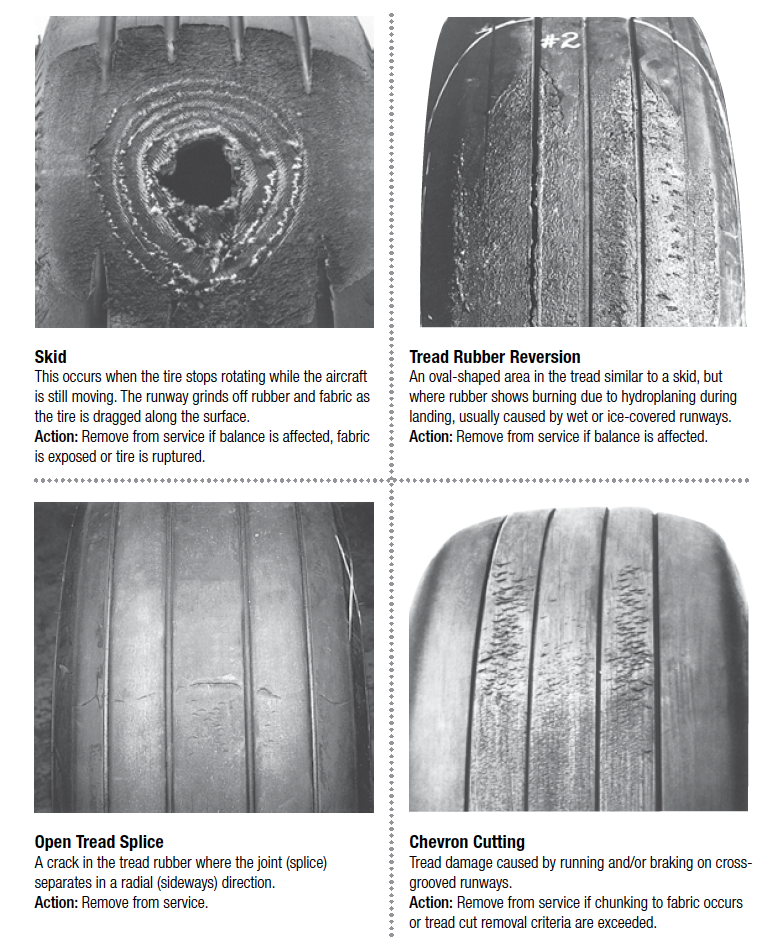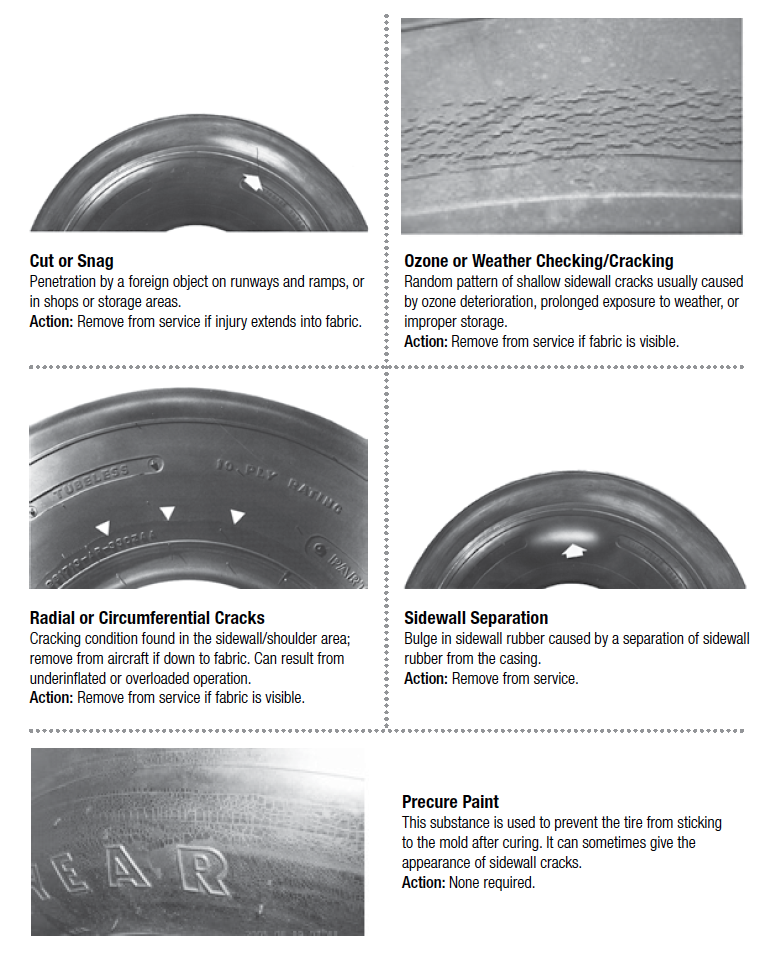Many of us tend to pay very little attention to our tires and for some of us there is a temptation to think of them as just like those we find on our cars. Those of us who are "shade tree mechanics" are particularly vulnerable, since we might think of ourselves as experts. But nothing could be further from the truth.
— James Albright

Updated:
2018-07-04
Aircraft tires are subject to huge temperature variations, have much higher pressures, and have much narrower tolerances on what is and isn't acceptable wear. You probably knew that. But how about this: aircraft tires are subject to very large swings in the amount of weight they must support and the resulting amount of sidewall flex can result in damage inside the tire that you cannot see from the outside and can result in a catastrophic tire explosion during takeoff and landing.
Much of what follows comes from Gulfstream but I think the lessons and conclusions can be extrapolated to any large aircraft. You should, of course, consult your aircraft and tire manufacturer manuals.

1
Tire pressure
You might think that the guidance given by most manufacturers (aircraft and tire) are probably filtered through lawyers who say you need to check your tires every day and that pressure tolerances are very small. In some cases that might be true. You will have to comb through the guidance provided for your aircraft. I've done that for a Gulfstream G450 to give you an idea on the process of getting your own answers.
How to check aircraft tire pressures?
The following extract comes from the G450 Maintenance Manual, but the techniques are universal. What follows are procedures to service the tires, that is, to add nitrogen. But the procedures hold true for checking the tire pressures.
- Remove cap from valve stem.
NOTE: Use only low pressure dry nitrogen to service tire.
Source: G450 Maintenance Manual, §12-33-02, ¶1.B.
"Low pressure" means something higher than what you need in the tire. We typically crank it up to between 300 and 400 psi. Dry nitrogen is important because you don't want any condensation inside the tire. But, more importantly, it has to be nitrogen and not air. Air is 78% nitrogen, 21% oxygen, and 1% other stuff. The oxygen is what you have to worry about when using ambient air in tires. Air is more sensitive to temperature changes and the normal heating caused by taxi, takeoff, and landing will cause air to increase in pressure to a much greater extent than pure nitrogen. Air is also more flammable and more likely to "bleed" through rubber.
- Connect hose from nitrogen servicing cart to tire inflator assembly.
WARNING: TO PREVENT SERIOUS INJURY, DO NOT STAND IN FRONT OF WHEEL FLANGES WHILE SERVICING TIRES.
Source: G450 Maintenance Manual, §12-33-02, ¶1.B.
Most aircraft wheels are of a "split rim" design. A conventional rim is made in one piece and the tire must be stretched over the rim. This is virtually impossible to do with many tires and the rim comes in sections so the tire can be installed on one section and then the second section is then secured to the first. What holds it all together? The rim itself has mating parts but the axle is also responsible for keeping both parts together. (That's why you should never remove a wheel from the axle without reducing the pressure first.) If any of this fails, the wheel will come apart. This is responsible for many deaths each year in the heavy trucking industry. Aircraft wheels have the same dangers.
- Service tire by connecting tire inflator assembly to valve stem.
Source: G450 Maintenance Manual, §12-33-02, ¶1.B.
You need to ensure the tire inflator assembly is aligned with the valve stem and be assertive with pushing everything together to avoid pressure loss.
- Disconnect tire inflator assembly and servicing cart hose.
Source: G450 Maintenance Manual, §12-33-02, ¶1.B.
Here again you need to be assertive when removing the inflator assembly to avoid having nitrogen leak out.
- Install cap on valve stem.
Source: G450 Maintenance Manual, §12-33-02, ¶1.B.
The cap not only serves as a safeguard from a slightly loose valve but also keeps foreign contaminants out from the valve.
- It is normal to lose 5% in 24 hours.
- Inaccurate gauges are a major source of improper inflation pressure.
- Check when cool.
- Never bleed off excess pressure from hot tires
We don't find this to be true in our operation. (See below)
Source: Gulfstream Presentation, "Tire Wear," John Salamankas
Another way to check tire pressure
Whenever you check a tire's pressure with a pressure gauge, you have to release a small amount of air/nitrogen to get the reading and that invariably costs you a PSI or two. There are add-on tire stems that allow an electronic reader to do the same thing without losing any pressure.
The "SmartStem" system from Crane Aerospace, for example, replaces your existing stems and includes an electronic pressure gauge. The cost for a typical business jet with 6 wheels is just over $6,000. Here's a video of the system in action: SmartStem Tire Pressure System. For more information: https://www.craneae.com/Products/Sensing/SmartStemBizJets.aspx.
Does the pressure have to be at the tire's maximum?
This depends on your aircraft manufacturer. In the case of a Gulfstream G450, we have a chart that correlates our tire pressures with the maximum grossweight expected before the next servicing.
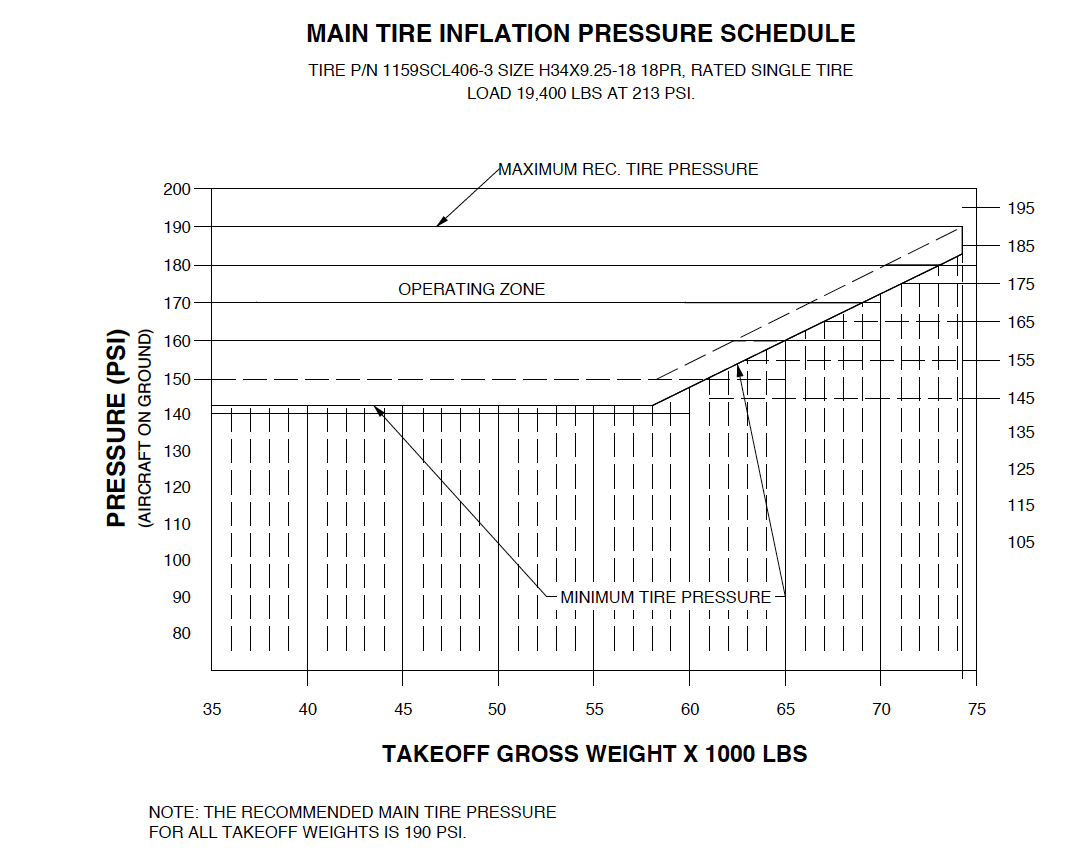
G450 Main tire inflation schedule, G450 Maintenance Manual, §12-33-02, figure 301.

G450 Nose tire inflation schedule, G450 Maintenance Manual, §12-33-02, figure 302.
- The graphs define recommended tire pressure to yield optimum tire life and the lowest operating tire temperatures. The operator is required to maintain the minimum tire pressure at each given weight. The maximum allowed tire pressure would be found by interpreting the charts with the aircraft maximum gross weight.
Source: G450 Maintenance Manual, §12-33-02, ¶1.B.
The Goodyear manual seems to indicate minimum pressure is based on maximum aircraft weight, but in this case the aircraft manufacturer's certification takes precedence.
- Pressures are based on takeoff weight, not landing weight.
- For weight off wheels conditions, subtract 4%.
Source: G450 Maintenance Manual, §12-33-02, ¶1.B.
What the manuals writers mean here is subtract 4% from your target. If you want 190 psi once the aircraft weight is on the wheel, for example, you will need to inflate to 190 - 4% (182 psi) if the weight of the aircraft is not on the wheel.
- Tire pressure varies with temperature change. For temperature corrections, add 1% pressure for each 5° F (2.8° C) above 70° F or subtract 1% for each 5° F (2.8° C) below 70° F.
Source: G450 Maintenance Manual, §12-33-02, ¶1.B.
These are ambient temperatures, those surrounding you and the tire. You need to give the temperature of the nitrogen inside the tire time to equalize after a flight or even a taxi operation. Simply towing the aircraft for a while will be enough to raise the temperature. We typically wait four hours after a flight before servicing the tires.
How often should tire pressures be checked?
Check daily with an accurate gauge. A visual inspection is inadequate.
Source: Gulfstream Presentation, "Tire Wear," John Salamankas
There is no specific guidance on how often to check tire pressures in the G450 Maintenance Manual. There is an argument to be made that checking pressures too often can be a problem, since the act of checking the pressures will normally result in a slight loss of nitrogen. I recommend:
- Check your aircraft and tire manufacturer manuals for guidance.
- Become familiar with your tire pressure loss tendencies. Here is what we found: (Your results will vary)
- After a new tire is mounted and inflated, we expect to see a 5% loss after the first 12 hours.
- We expect to see about a 7% loss after the first heat cycle (takeoff and landing).
- From that point on, we rarely see more than a ½ psi loss per week, even if the aircraft flies every day.
- Aircraft with smaller tires or mounted on used (un-rebuilt) wheels will have higher pressure loss patterns.
Who can check aircraft tire pressures?
Tire pressure affects more than wear, it also determines the aircraft's ability to takeoff, abort a takeoff, or stop following a landing. While this seems obvious, an under-inflated tire can be the cause of a catastrophic failure leading to loss of the airplane and its occupants, as was the case for Learjet 60, N999LJ.
Can you check your tires when you are on the road?
- In correspondence dated January 8, 2009, Learjet requested that the FAA provide a legal interpretation of “applicable rules in 14 CFR Parts 43, 91, and 135 pertaining to whether a pilot of a transport-category aircraft may check tire pressure during a normal preflight inspection.” On February 26, 2009, the FAA’s assistant chief counsel for regulations responded that checking the tire pressure on a Learjet 60 airplane is preventive maintenance and not a simple preflight task. The FAA stated that such checks involve high air pressure and require a calibrated gauge that must be used properly to ensure correct readings.
- Title 14 CFR 43.3(g) allows pilots to perform preventive maintenance on an aircraft operating under Part 91 but not aircraft operated under Parts 121, 129, or 135. The FAA noted that, “accordingly, a pilot operating [a Learjet 60] under … Part 91 may, in accordance with the provisions of 14 CFR 43.3(g), perform daily landing gear tire pressure checks. Under the same regulation, however, a pilot of that aircraft operating under Part 135 may not perform that task.” The FAA stated that any Part 135 Learjet 60 operator that may be adversely affected by the maintenance requirement may petition the FAA for relief from the regulation.
Source: NTSB AAR-10/02, ¶1.18.2.4
Flying commercially, a pilot cannot service the tires or even check the tire pressures.
If you are flying under 14 CFR 91, you may check tire pressures. If you want to do this, you should have your mechanic train you for the task and equip the aircraft with a properly calibrated gauge. We used to do this, but then realized that it was foolish to check tire pressures without a nitrogen bottle nearby. So we track our tire pressure loss patterns and ensure we have a mechanic perform a through flight inspection that includes tire pressure checks at least weekly.
How much pressure will be lost under normal use?
Once the tires have seen at least one heat cycle (taxi, takeoff, landing), we've found our tires don't lose more than ½ psi per week. But we have our wheels rebuilt with every tire change. When the wheel is rebuilt, it is completely torn down, cleaned, painted, and rebuilt. This ensures we have the best possible seal. If you are using unrebuilt wheels, your pressure loss will be higher. If you have smaller tires, your pressure loss will be higher. A local Falcon 2000 operator tells me they expect a loss of 2 psi per week but on occasion see 5 psi per week. A G150 operator tells me they see 2 psi on a three-day trip.
What happens when pressure goes too low?
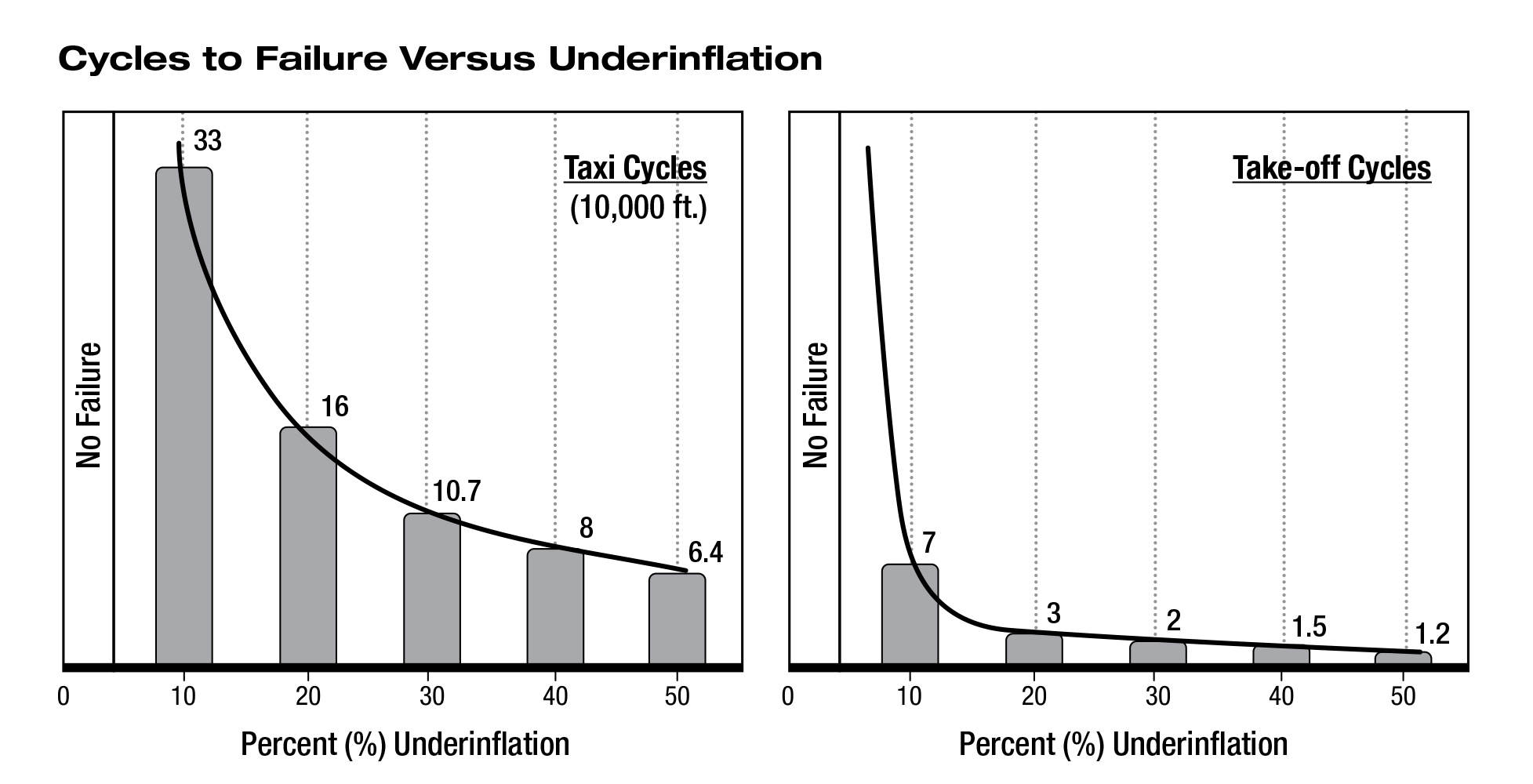
Cycles to failure versus underinflation, Goodyear Aviation Tire Manual, p. 50
The previously cited case study, Learjet 60, N999LJ, provides a lot of evidence about just how dangerous under-inflated tires can be. That aircraft's manual called for tire replacement if pressure falls below 15%. In general, under-inflating a tire by 20% can lead to a tire failure after just three takeoffs.
Correct inflation is most important factor.
Source: Gulfstream Presentation, "Tire Wear," John Salamankas
If your tires are under-inflated, you will have increased and possibly uneven tire wear.
2
Wear patterns
You can get yourself into trouble by carrying over older guidance to new, or other aircraft to your current. I have flown aircraft that actually allowed wear into the cord of a tire. In fact, some allowed several cords to be exposed. My current aircraft requires the tires be replaced if any of the treads are worn to their base. There are also rules covering cuts. You need to consult your manuals when evaluating whether or not a tire needs to be replaced.

G450 MM, § 32-42-03, Figure 601
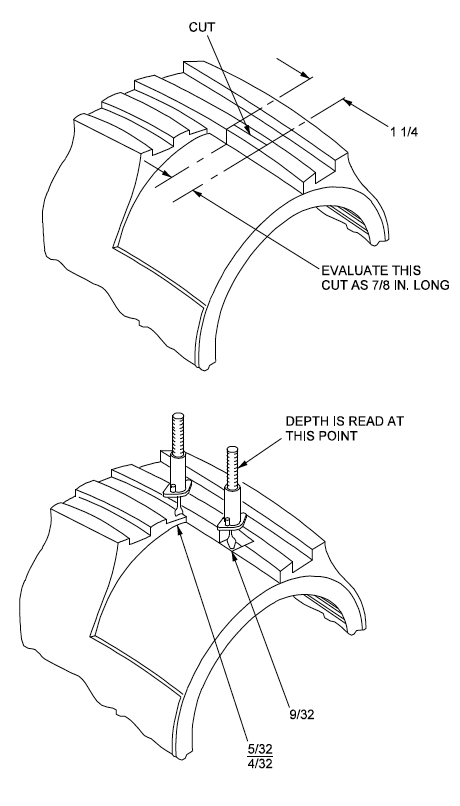
G450 MM, § 32-42-03, Figure 602
3
Gulfstream recommendations
Gulfstream used to hold a breakfast every Wednesday in Savannah to cover the latest concerns from out in the field. The information was so good they started publishing the better topics in something called the "Breakfast Minutes." Here are those notes about the importance of properly inflated tires.
Following are the nine steps of proper inflation procedures. (When servicing assemblies, always use a bottle or supply line with a pressure regulator, which should be set 50 percent higher than the rated pressure of the tire. Extreme over-inflation from an unregulated pressure supply can cause the wheel or tire to burst, leading to injury or death).
- Check Tires Daily When They Are Cool – Tire pressures should always be checked with the tire at ambient temperatures. Tire temperatures can rise in excess of 200°F (93°C) above ambient during operation. A temperature change of 5°F (3°C) produces approximately 1 percent pressure change. It can take up to three hours after a flight for tire temperatures to return to ambient. (Gulfstream Aircraft Maintenance Manuals recommend an approximate 2-hour wait.)
- Inflate To Worst Conditions – When tires are going to be subjected to ground temperature changes in excess of 50°F (27°C) because of flight to a different climate, inflation pressures should be adjusted to worst case prior to takeoff so that the minimum required inflation is maintained for the cooler climate. This also applies when inflating tires inside heated hangars.
- Use Dry Nitrogen Gas – Nitrogen will not sustain combustion and will reduce degradation of the liner material, casing plies, and wheel due to oxidation. (It also has a lower moisture content to prevent freezing.)
- Increase Pressure 4% For Tires Under Load – A tire under the load of an aircraft has 4 percent higher pressure than it does when unloaded. Therefore, if unloaded pressure has been specified in the manual, but the tire is being checked on the aircraft, that number should be increased by 4 percent to obtain the equivalent loaded inflation pressure.
- Allow 12-Hour Stretch After Mounting Tires – All tires, particularly bias tires, will stretch 5. (or grow) after initial mounting and inflation. This increased volume of the tire results in a pressure drop. Consequently, tires should not be placed in service until they have been inflated a minimum of 12 hours, pressure rechecked, and tires re-inflated if necessary.
- Never Reduce Pressure On A Hot Tire – Excess inflation pressure should never be bled off from hot tires. All adjustments to inflation pressure should be performed on tires cooled to ambient temperature.
- Equal Pressure For Duals – To prevent one tire on a gear from carrying extra load, all tires on a single gear should be inflated equally. The mate tires will share the load, allowing individual tires to run under-inflated or overloaded even though all tires on the gear are deflected identically.
- Calibrate Inflation Gauge Regularly – Use an accurate, calibrated gauge. Inaccurate gauges are a major source of improper inflation pressures. Gauges should be checked periodically and recalibrated as necessary.
- Inflation Pressure Loss Troubleshooting – Since there are many causes for inflation pressure loss with a tubeless assembly, a systematic troubleshooting approach is advisable for minimum maintenance costs. Moreover, when chronic but not excessive inflation pressure loss exists, other factors such as inaccurate gauges, air temperature fluctuations, changes in maintenance personnel, etc., may be the source.
Source: Gulfstream Breakfast Minutes, 30 July 2013, "The Importance of Properly Inflated Tires
4
Goodyear recommendations
Goodyear Aircraft Tire Care & Maintenance Manual is quite good, but it covers are wide range of tires. You need to check your aircraft manufacturer manuals as well.
Inspecting Mounted Tires
Systematic inspection of mounted tires is strongly recommended for safety and tire economy. The frequency of the inspection should be determined by the use and normal tire wear of the particular aircraft involved. With some aircraft, tire inspection after every landing or at every turnaround is required. With all aircraft, a thorough inspection is advisable after a hard landing.
Tread wear
Inspect treads visually and check remaining tread. Tires should be removed when tread has worn to the base of any groove at any spot, or to a minimum depth as specified in aircraft manuals.
Return to Base Limits
In order to return to a maintenance base, Goodyear tires can remain in service with top ply cord visible, but only as long as the cord is not worn through or exposed for more than 1/8 of the circumference of the tire or not more than 1 inch wide at the fastest wearing location. Tires within these limits can continue in service no longer than necessary to return to a maintenance base and be replaced. (This applies to the proper tires for the aircraft as specified in its aircraft manual.) For all other circumstances, normal removal criteria are still recommended as per the rest of this manual. This does not apply to military tires with Maximum Wear Limits marked on the sidewall.
NOTE: Further use of tires beyond return to base limits may render a tire unsafe or unretreadable.
Uneven Wear
If tread wear is excessive on one side, the tire can be demounted and turned around, providing there is no exposed fabric. Gear misalignment causing this condition should be corrected.
Tread Cuts
Inspect tread for cuts and other foreign object damage and mark with crayon or chalk. Follow the removal criteria below:
- Follow specific cut removal criteria from the aircraft manual, or tire cut limits on the tire sidewall when available.
- When specific cut removal criteria are not available use the following Goodyear removal criteria: any cut into the casing plies on bias tires, any cut into the belt package on radial tires, any cut which extends across one or more rubber tread ribs to the fabric, rib undercutting at the base of any cut.
WARNING
DO NOT PROBE CRACKS, CUTS, OR EMBEDDED FOREIGN OBJECTS WHILE TIRE IS INFLATED. THIS COULD CAUSE THE OBJECT TO BECOME A PROJECTILE OR THE TIRE TO EXPLODE, WHICH CAN RESULT IN SERIOUS OR FATAL INJURY.
Sidewall Damage
Remove tire from service if weather checking, cracking, cuts and snags extend down to the casing ply in the sidewall and bead areas.
Bulges
Bulges in any part of tire tread, sidewall or bead area indicate a separation or damaged tire. Mark with crayon and remove from service immediately.
Fabric Fraying/Groove Cracking
Tires should be removed from service if groove cracking exposes fabric or if cracking undercuts tread ribs.
Flat Spots
Generally speaking, tires need not be removed because of flat spots due to touchdown and braking or hydroplaning skids unless fabric is exposed. If objectionable vibration results, however, rebalance the assembly or remove the tire from service.
Casing Flat Spotting
Loaded tires that are left stationary for any length of time can develop temporary flat spots. The degree of this flat spotting depends upon the load, tire deflection and temperature. Flat spotting is more severe and more difficult to work out during cold weather. Under normal conditions, a flat spot will disappear by the end of the taxi run.
Radial Tire Sidewall Indentation
Remove from service if sidewall indentation is 3mm deep or greater.
Beads
Inspect bead areas next to wheel flanges for damage due to excessive heat, especially if brake drag or severe braking has been reported during taxi, take-off or landing. If damaged, remove tire from service.
Tire Clearance
Look for marks on tires, gear, and in wheel wells that might indicate rubbing due to inadequate clearance.
Wheels
Check wheels for damage. Wheels that are cracked or damaged should be taken out of service for repair or replacement in accordance with manufacturer’s instructions.
Source: Goodyear Aircraft Tire Care & Maintenance Manual, pages 26-34
References
(Source material)
Goodyear Aircraft Tire Care & Maintenance Manual
Gulfstream G450 Maintenance Manual, Revision 18, Dec 12, 2013
NTSB Aircraft Accident Report, AAR-10/02, Runway Overrun During Rejected Takeoff, Global Exec Aviation, Bombardier Learjet 60, N999LJ, Columbia, South Carolina, September 19, 2008
Salamankas, John, Tire Wear.
Please note: Gulfstream Aerospace Corporation has no affiliation or connection whatsoever with this website, and Gulfstream does not review, endorse, or approve any of the content included on the site. As a result, Gulfstream is not responsible or liable for your use of any materials or information obtained from this site.

